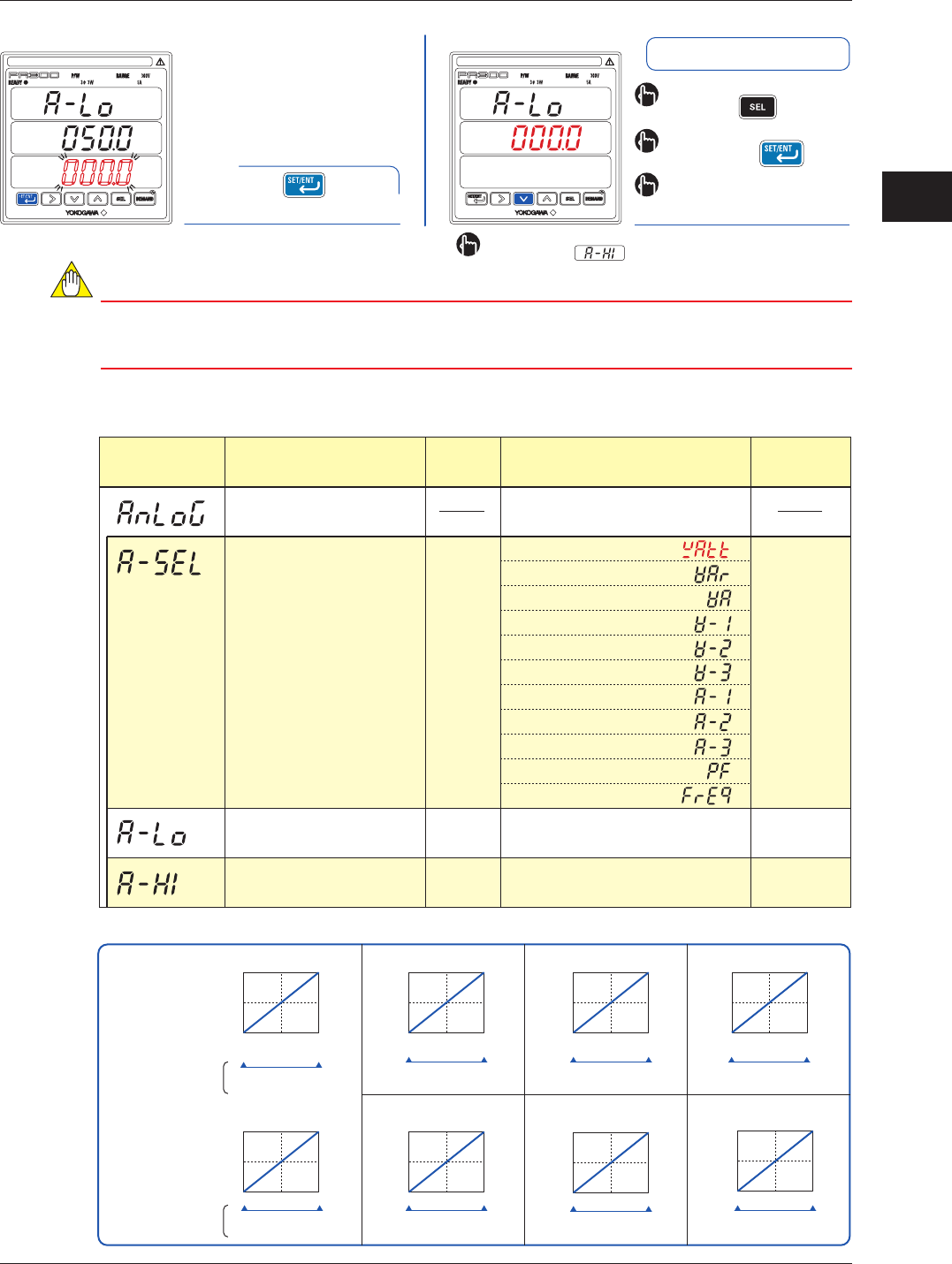Energy Meter Manual
Table Of Contents
- Introduction
- Notices
- Checking the Package
- Checking the Model and Suffix Codes
- Contents
- Chapter 1 Installation and Wiring
- 1.1 Installation with the ANSI 4-inch Round Form or JIS 110-square Instrument Size
- 1.2 Installation with the DIN 96-square Instrument Size
- 1.3 Wiring
- Crimping Terminal Recommendations
- Single-phase two-wire system (voltage input, current input, power supply)
- Single-phase three-wire system (voltage input, current input, power supply)
- Three-phase three-wire system (voltage input, current input, power supply)
- Three-phase four-wire system (voltage input, current input, power supply)
- Three-phase four-wire system (2.5 element) (voltage input, current input, power supply)
- Other Wiring
- 1.4 Attaching the Dust Cover and Terminal Cover
- Chapter 2 Preparations before Starting Measurement (Set up the PR300 First)
- Chapter 3 Parameter Setting Operations
- 3.1 Basic Parameter Setting Operations
- 3.2 Setting the VT and CT Ratios
- 3.3 Setting the Integrated Low-cut Power
- 3.4 Setting RS-485 Communication Conditions
- 3.5 Setting Ethernet Communication Conditions
- 3.6 Setting Pulse Output Conditions
- 3.7 Setting Analog Output Conditions
- 3.8 Setting Demand Measurement Conditions
- 3.9 Setting the Measured Value Display Pattern
- 3.10 Setting the “Indicator-out” Mode and Locking Parameters
- Chapter 4 Operation for Display of Measurement Items and Measurement Method
- 4.1 Measurement Items
- 4.2 Switching Display Pattern
- 4.3 Displaying Measured, Instantaneous, and Maximum/Minimum Values
- Example Display and Measuring Ranges of Active Power (Regenerative Power)
- Example Display and Measuring Ranges of Reactive Power
- Example Display and Measuring Ranges of Apparent Power
- Example Display and Measuring Ranges of Voltage
- Example Display and Measuring Ranges of Current
- Example Display and Measuring Ranges of Power Factor
- Example Display and Measuring Ranges of Frequency
- How to Switch between Instantaneous Value, Maximum Value, and Minimum Value
- 4.4 Phase Switching for Voltage and Current
- 4.5 Displaying Energy Values
- 4.6 Resetting Measured Values
- 4.7 Demand Measurement (Optional Measuring Function)
- Chapter 5 Troubleshooting
- Appendix
- Appendix 1 Specifications of PR300
- Measuring Function
- Power Items and Equations
- Input Specifications
- Digital Input Specifications
- Analog Output Specifications (additional output function)
- Pulse Output Specifications (additional output function)
- Demand Alarm Output Specifications (optional measuring function)
- Communication Specifications
- Standard Performance
- Safety and EMC Standards
- Environmental Conditions
- Mounting and Shape
- Appendix 2 System Reset
- Appendix 3 Parameter Map
- Appendix 4 Parameter List
- Appendix 5 Alphanumeric Characters Table for 7-segment LED
- Appendix 1 Specifications of PR300
- Index
- A
- C
- D
- E
- H
- I
- M
- O
- P
- R
- S
- T
- V
- W
- Wiring diagram
- Single-phase two-wire system
- Single-phase three-wire system
- Three-phase three-wire system
- Three-phase four-wire system
- Three-phase four-wire system (2.5 element)
- Analog output
- Demand alarm output
- Demand alarm release
- Ethernet communication
- Integration control signal
- Palse output
- RS-485 communication
- Wiring diagram

Parameter Setting Operations
3-13
IM 77C01E01-01E
1
2
3
4
5
A
I
3.7 Setting Analog Output Conditions
To change the upper limit of scaling, set a new limit using
the parameter that follows.
Lower Limit of Scaling
screen
Lower limit of scaling setting
completed.
To return to the Analog Output Menu
screen, press .
Lower Limit of Scaling
Setting screen
Press once while
the setpoint is blinking.
The setpoint is confirmed and the PR300
returns to the Lower Limit of Scalling screen.
To return to the Measured Value
screen, hold down .
If you do not operate any key for more
than 5 minutes on the Parameter
screen, the PR300 automatically
returns to the Measured Value screen.
11
NOTE
If the upper and lower limits of scaling do not satisfy the following conditional expression, the updated
upper or lower limit of scaling setpoint will not be incorporated but revert to the value before change.
Upper limit of scaling – Lower limit of scaling 50
Parameter Setting Types and Ranges
Analog output menu
Measurement item for
analog output
Lower limit of scaling
Upper limit of scaling
Selection
Fixed-point
numeric
value
Fixed-point
numeric
value
Active power
Reactive power
Apparent power
Voltage-1
Voltage-2
Voltage-3
Current-1
Current-2
Current-3
Power factor
Frequency
0.0 to 50.0 (%)
50.0 to 100.0 (%)
Active power
100.0
50.0
Menu to shift to the parameters of
analog output
Parameter Symbol Parameter Name
Setting
Type
Setting Range (Details)
Initial Value
(Factory-set
Value)
Relationship between Scale Values and Measurement Inputs (Example)
4
20
-1000
0
Lower
limit
Upper
limit
Lower
limit
Upper
limit
Lower
limit
Upper
limit
Lower
limit
Upper
limit
Lower
limit
Upper
limit
Lower
limit
Upper
limit
Lower
limit
Upper
limit
Lower
limit
Upper
limit
Scale values
to be set
100
0
1000
Output
mA
(W)
4
20
0
1000
Output
mA
(W)
50 100
When setting
output
proportional to
-1000 to 1000 W
When setting
output
proportional to
0 to 1000 W
Active power
4
20
-1000
(LEAD)
0100
0 1000
(LAG)
Output
mA
(var)
Reactive power
4
20
0
0100
1000
Output
mA
(VA)
Apparent power
4
20
01
0100
600
Output
mA
(V)
Voltage
4
20
0
0100
5
Output
mA
(A)
Current
4
20
45
0100
65
Output
mA
(Hz)
Frequency
4
20
0.5
(LEAD)
0 100
0.5
(LAG)
Output
mA
Power factor
Scale values
to be set










